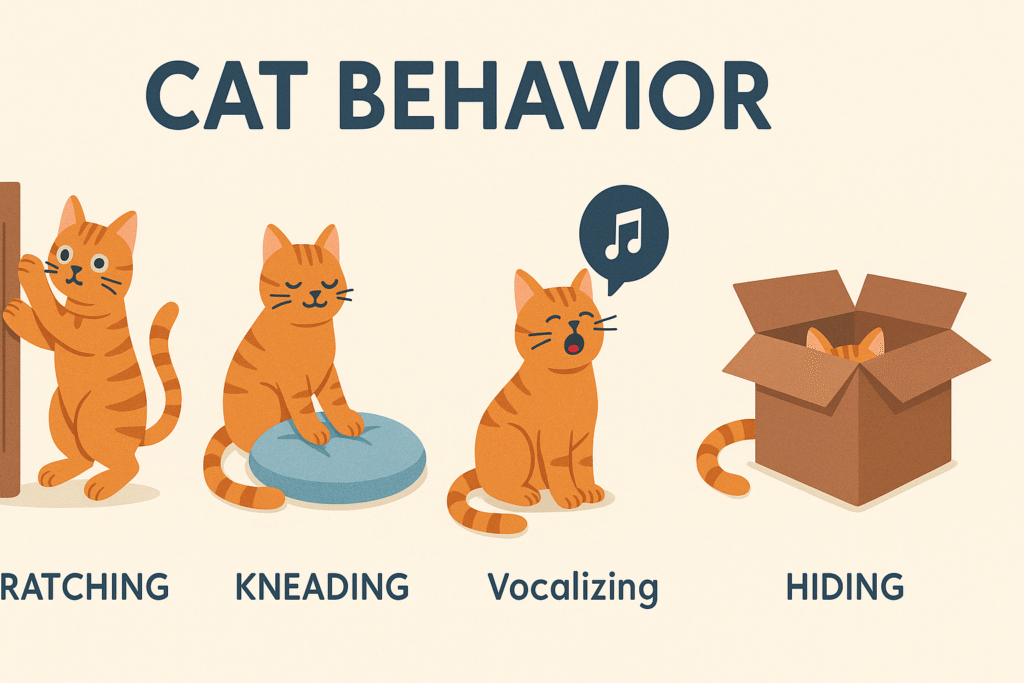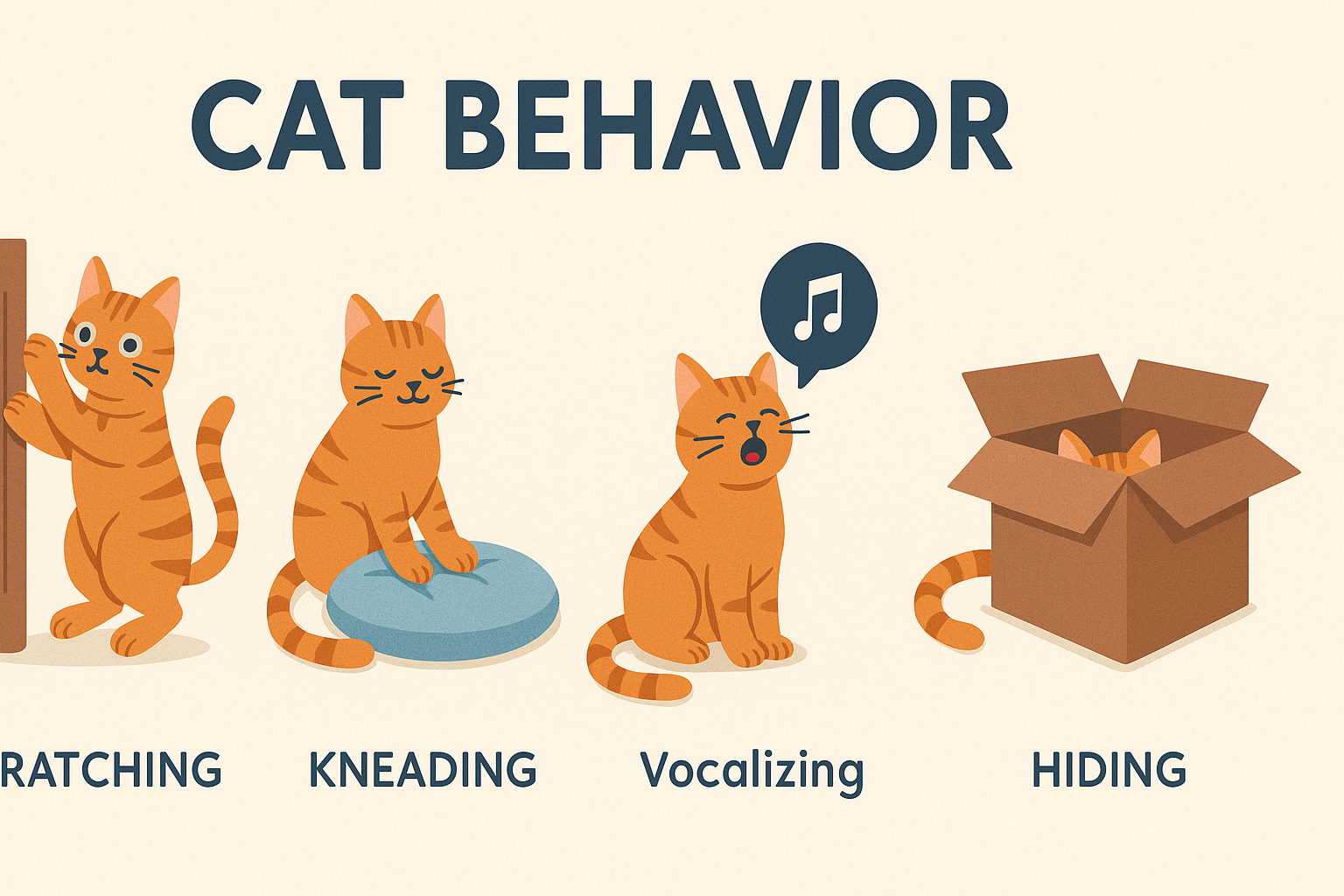Cats have a reputation for being mysterious, but their body language is a rich source of information about their feelings, needs, and intentions. Learning to interpret these signals can help you build a stronger bond with your feline companion, avoid misunderstandings, and provide the best possible care.
In this comprehensive guide, we will explore the many ways cats communicate through posture, facial expressions, tail movements, vocalizations, and more, so you can better understand what your cat is trying to tell you.

Why Cat Body Language Matters
Cats are highly expressive animals, but their communication style is subtle. Unlike dogs, who often use overt gestures and sounds, cats rely on small changes in body posture, ear position, tail movement, and facial expressions to convey their emotions. Understanding these cues is essential for any cat owner, as it allows you to:
- Recognize when your cat feels happy, relaxed, or playful
- Identify signs of stress, fear, or anxiety
- Respond appropriately to aggression or discomfort
- Build trust and strengthen your relationship
Cats also use body language to communicate with other cats, establishing social hierarchies, boundaries, and friendships within multi-cat households or outdoor colonies.
The Basics of Cat Body Language
Posture
A cat’s overall posture is one of the most telling indicators of its mood:
- Relaxed and Content: A cat that feels safe and comfortable will have a loose, flexible body. The tail may be held low or curled around the body, and the ears are in a neutral position. The eyes are often half-closed, and the mouth is closed or slightly open.
- Alert or Curious: When something catches a cat’s attention, its body becomes slightly tense, and it may stand tall or crouch with its hindquarters raised, ready to pounce. The ears point forward, the eyes are wide open, and the tail is upright or twitching.
- Fearful or Defensive: A frightened cat will crouch low to the ground, with its body tense and ready to bolt. The tail may be tucked tightly under the body or wrapped around the side. Ears flatten against the head, and eyes are wide open with dilated pupils.
- Aggressive: An aggressive cat may arch its back, puff up its fur, and stand sideways to appear larger. The tail is often puffed and lashing, and the ears are flattened back. The cat may hiss, growl, or swat if approached.
Tail Movements
The tail is one of the most expressive parts of a cat’s body. Here’s what different tail positions can mean:
| Tail Position | Likely Meaning |
| Upright with a curl at the tip | Happy, confident, greeting |
| Upright and puffed | Frightened, defensive, trying to appear big |
| Low or tucked | Anxious, fearful, submissive |
| Swishing or flicking | Excited (during play) or annoyed |
| Lashing side to side | Angry, highly aroused, ready to react |
| Curled around body | Relaxed, content |
A playful cat’s tail is often upright and may swish quickly or flick side to side, especially during play or hunting behaviors. If the cat is stalking, this movement shows focus and anticipation. However, a flicking tail outside of play often signals irritation or agitation.
Ears
Cats’ ears are highly mobile and can communicate a lot:
- Forward and upright: Relaxed, interested, playful, or happy.
- Backward or sideways (“airplane ears”): Stressed, anxious, or annoyed.
- Flat against the head: Fearful, defensive, or aggressive.
- Swiveling: Monitoring surroundings for threats, especially when anxious or stressed.
Eyes
A cat’s eyes reveal much about its emotional state:
- Slow blinking: Trust and affection. Cats often slow blink at people and other cats they trust. You can return the gesture to show your cat you feel the same.
- Wide open with dilated pupils: Excitement, fear, or high arousal. This can occur during play, when startled, or when scared.
- Half-closed or soft: Relaxed, content, or sleepy.
- Narrowed pupils: Anger, aggression, or intense focus.
Whiskers and Mouth
- Whiskers forward: Excitement, curiosity, or hunting mode.
- Whiskers pulled back: Fear, anxiety, or feeling threatened.
- Mouth open (panting, hissing, growling): Stress, fear, or aggression.
- Closed mouth: Relaxed or neutral state.
Playful Cat Body Language
Play is an essential part of a cat’s life, providing both physical exercise and mental stimulation. When a cat is feeling playful, its body language becomes lively and animated:
- Eyes: Wide open, pupils may be dilated.
- Ears: Forward and alert, focused on the “prey” (often a toy or moving object).
- Tail: Upright, swishing, or flicking side to side.
- Body posture: Crouched low, hindquarters raised, ready to pounce. Cats may also display “zoomies,” racing around the house in bursts of energy.
- Vocalizations: Some cats chirp or trill when excited, while others remain silent.
Playful behavior often mimics hunting, with stalking, chasing, pouncing, and grabbing. Providing toys and interactive playtime is important for your cat’s health and happiness.
Signs of Stress or Anxiety
Cats are sensitive to changes in their environment, and stress can manifest in both behavior and body language. Common triggers include loud noises, new people or pets, changes in routine, or unfamiliar places.
Body language of a stressed or anxious cat:
- Tail: Low, tucked close to the body, or held stiffly. The tip may twitch, indicating nervousness.
- Body posture: Crouched low, tense, sometimes frozen in place. The cat may slink along walls or hide.
- Ears: Flattened slightly backward or swiveling to monitor the environment.
- Eyes: Wide open, pupils dilated, giving a startled or on-edge appearance.
- Vocalizations: Increased meowing, growling, or yowling. Some cats become unusually quiet.
- Displacement behaviors: Licking lips, grooming excessively, scratching, or yawning out of context.
If you notice these signs, try to identify and remove the source of stress. Provide hiding spots, maintain a consistent routine, and use calming pheromone products if necessary.
Aggressive Cat Body Language
Aggression in cats can be startling, but it is often a last resort when a cat feels threatened or cornered. Recognizing the warning signs can help prevent bites or scratches and address the underlying cause.
Warning Signs of Aggression
- Body posture: The cat may arch its back, stand sideways, and puff up its fur to appear larger. This is called “piloerection.” The cat’s stance is stiff and rigid.
- Tail: The tail is puffed up and may be held straight up, down, or lashing side to side.
- Ears: Flattened tightly against the head, sometimes turned backward.
- Eyes: Pupils are often narrowed, and the cat may stare directly at the perceived threat.
- Whiskers: Pulled back tightly against the face.
- Vocalizations: Hissing, growling, spitting, or yowling. These sounds are meant to warn others to back off.
- Other behaviors: Swatting with claws extended, lunging, or biting.
Types of Aggression
- Fear aggression: Occurs when a cat feels trapped or unable to escape. The cat may display defensive behaviors like hissing, swatting, or biting if approached.
- Territorial aggression: Cats are territorial animals. They may become aggressive if they perceive an intruder (another cat, dog, or even a person) in their space.
- Redirected aggression: Sometimes, a cat becomes agitated by something it cannot reach (like a bird outside the window) and lashes out at a nearby person or animal.
- Play aggression: Young cats and kittens may play rough, biting and swatting during play. This is normal but should be redirected to toys.
If your cat shows signs of aggression, give it space and avoid punishment. Instead, try to identify the cause and address it calmly. Consult a veterinarian or animal behaviorist if aggression is frequent or severe.
Affectionate Cat Body Language
Cats are often thought of as aloof, but they have many ways of showing love and affection. These signals can be subtle, so it’s important to recognize them.
Signs of Affection
- Slow blinking: When a cat looks at you and slowly closes and opens its eyes, it is expressing trust and affection. You can return the gesture by slow blinking back.
- Head bunting: Cats rub their heads or cheeks against people, objects, or other animals to mark them with their scent. This is a sign of trust and bonding.
- Purring: While purring can also indicate pain or distress, it is most often a sign of contentment and comfort when accompanied by relaxed body language.
- Kneading: Cats press their paws alternately against soft surfaces, a behavior rooted in kittenhood. Adult cats knead when they feel safe and happy.
- Tail language: A cat that approaches you with its tail upright, sometimes with a little quiver at the tip, is greeting you with affection.
- Following you: Cats often follow their favorite people from room to room as a sign of attachment.
- Bringing “gifts”: Some cats bring toys, prey, or other objects to their owners as a form of sharing or teaching.
Cuddling and Sleeping
Cats are most vulnerable when sleeping, so if your cat chooses to nap near you, on your lap, or even on your chest, it is a clear sign of trust. Some cats enjoy being held or cuddled, while others prefer to show affection from a slight distance. Respect your cat’s preferences and never force physical contact.
Communication Between Cats
Cats communicate with each other using the same body language signals they use with humans, but the context and meaning can vary.
Social Hierarchies
In multi-cat households, cats establish social hierarchies through body language, grooming, and scent marking. Dominant cats may claim certain resting spots, rub their scent on objects, or initiate grooming sessions. Submissive cats may avoid direct eye contact, crouch, or retreat.
Friendly Interactions
- Allogrooming: Cats that are friendly with each other often groom one another, especially around the head and neck. This reinforces social bonds.
- Nose touching: Cats greet each other by touching noses, which is a friendly gesture.
- Sleeping together: Cats that trust each other may sleep in close proximity or even curled up together.
Conflict and Avoidance
- Staring: A direct stare can be a challenge or a sign of dominance.
- Blocking: Dominant cats may block access to food, litter boxes, or favorite spots.
- Hissing and growling: These are clear signals to back off.
If you have multiple cats, provide plenty of resources (food bowls, litter boxes, resting spots) to minimize competition and stress.
How to Respond to Your Cat’s Body Language
Understanding what your cat is trying to tell you is only half the equation. Responding appropriately is key to building trust and a positive relationship.
When Your Cat is Relaxed or Affectionate
- Interact gently: Pet your cat in the areas it enjoys, such as the head, cheeks, or under the chin.
- Return slow blinks: This reassures your cat that you are friendly and relaxed.
- Respect boundaries: If your cat walks away or signals that it has had enough, let it go.
When Your Cat is Playful
- Use toys: Engage your cat with interactive toys like feather wands, balls, or laser pointers. Avoid using your hands or feet as toys to prevent play aggression.
- Encourage hunting behaviors: Allow your cat to stalk, chase, and pounce on toys to satisfy its natural instincts.
When Your Cat is Anxious or Stressed
- Provide safe spaces: Give your cat access to hiding spots, high perches, or quiet rooms.
- Maintain routines: Cats thrive on predictability, so keep feeding, play, and cleaning schedules consistent.
- Use calming aids: Products like Feliway (a synthetic feline facial pheromone) can help reduce stress in some cats (source: International Cat Care).
- Avoid punishment: Never yell at or physically punish your cat. This can increase fear and damage your relationship.
When Your Cat is Aggressive
- Back off: Give your cat space and time to calm down.
- Identify triggers: Try to determine what caused the aggression and address it if possible.
- Seek professional help: If aggression is frequent or severe, consult your veterinarian or a certified animal behaviorist.
Special Considerations: Senior Cats and Kittens
Senior Cats
Older cats may develop arthritis or other health issues that affect their body language. They may move more slowly, be less playful, or show signs of pain such as limping or reluctance to jump. Watch for subtle changes and consult your veterinarian if you notice anything unusual.
Kittens
Kittens are learning how to communicate through play and social interactions. They may be more vocal, playful, and exploratory. Gentle handling and positive experiences help them grow into confident adults.
Common Myths About Cat Body Language
Despite the wealth of information available, several myths about cat behavior persist. Understanding the truth behind these misconceptions is vital for interpreting your cat’s signals accurately.
Myth 1: Cats Are Always Aloof and Independent
While cats are more independent than dogs, they are not emotionless or indifferent. Many cats form deep bonds with their owners and express affection in subtle ways, such as slow blinking, head bunting, or following you around. Some breeds, like the Siamese or Ragdoll, are especially social and crave human interaction (source: American Association of Feline Practitioners).
Myth 2: A Wagging Tail Means a Happy Cat
Unlike dogs, a wagging or lashing tail in cats is usually a sign of irritation, excitement, or agitation, not happiness. If your cat’s tail is flicking rapidly, it’s best to give them space and observe for other signs of stress.
Myth 3: Purring Always Means Contentment
Purring is often a sign of contentment, but cats also purr when they are frightened, in pain, or even dying. If your cat is purring while displaying other signs of distress (such as hiding, panting, or lethargy), consult your veterinarian.
Myth 4: Cats Scratch Furniture Out of Spite
Scratching is a natural behavior for cats. It helps them mark territory, stretch their muscles, and maintain healthy claws. Cats do not scratch out of spite or anger. Providing appropriate scratching posts can help redirect this behavior.
Myth 5: All Cats Hate Water
While most cats dislike being submerged, many are fascinated by running water and may enjoy playing with a dripping faucet. Some breeds, like the Turkish Van, are even known to swim.
Tips for Observing and Understanding Your Cat
Learning to read your cat’s body language takes time and patience. Here are some practical tips to help you become more attuned to your cat’s signals:
1. Observe the Whole Body
Don’t focus on just one feature, such as the tail or ears. Look at your cat’s overall posture, facial expression, and movement. For example, a cat with upright ears and a relaxed body is likely content, even if its tail is moving slightly.
2. Consider the Context
A cat’s body language can change depending on the situation. A crouched posture may indicate play when stalking a toy, but fear when hiding from a loud noise. Always consider what is happening around your cat.
3. Learn Your Cat’s Unique Signals
Every cat is an individual. Some are naturally more vocal or expressive, while others are more reserved. Pay attention to your cat’s habits and routines to better understand its personal communication style.
4. Watch for Changes
Sudden changes in body language or behavior can signal health problems or stress. If your usually outgoing cat becomes withdrawn, or if a calm cat starts hissing or swatting, it’s time to investigate further.
5. Use Positive Reinforcement
Reward your cat with treats, praise, or play when it displays relaxed or affectionate behavior. This helps reinforce positive interactions and builds trust.
6. Respect Boundaries
If your cat signals that it wants to be left alone (flattened ears, lashing tail, or moving away), respect its wishes. Forcing interaction can lead to fear or aggression.
How to Build a Stronger Bond With a Cat Through Understanding
Interpreting your cat’s body language is not just about avoiding scratches or bites. It’s about building a relationship based on trust, respect, and communication. When you respond to your cat’s signals appropriately, you create a safe and supportive environment where your cat can thrive.
Benefits of Understanding Cat Body Language
- Improved health and wellbeing: Recognizing signs of stress or illness early can lead to prompt veterinary care.
- Stronger bond: Responding to your cat’s needs and respecting its boundaries builds trust.
- Reduced behavioral problems: Understanding triggers for aggression or anxiety allows you to prevent or manage unwanted behaviors.
- Happier home: A cat that feels understood and secure is more likely to be affectionate, playful, and relaxed.
When to Seek Professional Help
Sometimes, changes in body language or behavior signal underlying medical or behavioral issues. If you notice any of the following, consult your veterinarian or a certified animal behaviorist:
- Sudden or severe aggression
- Persistent hiding or withdrawal
- Changes in appetite, litter box habits, or grooming
- Signs of pain, such as limping or vocalizing when touched
- Excessive grooming or self-mutilation
Early intervention can prevent problems from escalating and ensure your cat’s health and happiness.
Conclusion
Cats are complex, intelligent, and emotionally rich animals. While their body language may seem mysterious at first, with patience and careful observation, you can learn to “read” your cat and respond in ways that meet its needs.
Remember, every cat is unique, so take the time to get to know your feline companion as an individual.
By understanding cat body language, you are not only improving your cat’s quality of life but also enriching your own experience as a cat owner. The silent conversations you share with your cat will become one of the most rewarding aspects of your relationship.
Sources:
- International Cat Care: icatcare.org
- American Association of Feline Practitioners: catfriendly.com
- Cornell Feline Health Center: vet.cornell.edu
- 9 Types of Lovebirds (A Comprehensive Guide for Pet Bird Owners) - June 20, 2025
- Labrador Retriever: America’s Most Beloved Family Dog - June 9, 2025
- The Complete Guide to Indian Ringneck Parrots - June 9, 2025















